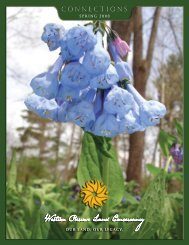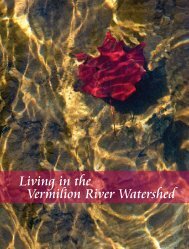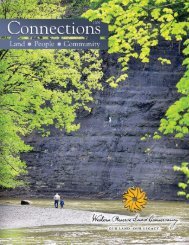Common Ground - Western Reserve Land Conservancy
Common Ground - Western Reserve Land Conservancy
Common Ground - Western Reserve Land Conservancy
You also want an ePaper? Increase the reach of your titles
YUMPU automatically turns print PDFs into web optimized ePapers that Google loves.
AMANDA SKINGEL<br />
term. According to the U.S. Census, the current economy<br />
has reduced the annual construction rate to around 3,000<br />
new privately-owned residential building permits in northern<br />
Ohio. This is down from more than 13,000 permits regionally<br />
in 2004. Paired with this reduced rate of development are<br />
unusually low property values; this creates a potential<br />
opportunity for the region to increase the pace of<br />
conservation considerably. <strong>Land</strong> once eyed for development<br />
might instead be preserved.<br />
In addition to protecting our region’s land, there is a strong<br />
need to quantify its health and restore some of the altered<br />
natural areas, including our degraded streams and wetlands.<br />
Examples of this include The Nature <strong>Conservancy</strong>’s work<br />
to control invasive species in the Grand River Lowlands,<br />
the restoration of the former Orchard Hills Golf Course by<br />
Geauga Park District and <strong>Western</strong> <strong>Reserve</strong> <strong>Land</strong> <strong>Conservancy</strong><br />
and the reclamation of the former Coliseum site by the<br />
Trust for Public <strong>Land</strong> and the National Park Service. Other<br />
restoration projects are featured throughout this report.<br />
12 CHAPTER 2 WHERE WE STAND<br />
So who is conserving land in our region?<br />
There are a number of government agencies, nonprofit<br />
organizations, schools, clubs and individuals working<br />
throughout our region to protect land.<br />
Federal government agencies that own or protect land in<br />
northern Ohio include the National Park Service, NASA, U.S.<br />
Fish and Wildlife Service and U.S. Department of Agriculture’s<br />
Natural Resources Conservation Service. They own or protect<br />
land for different reasons, but each contributes to the overall<br />
matrix of open land in our region. In northern Ohio, NRCS<br />
largely protects land in voluntary partnership with private<br />
landowners through Farm Bill programs.<br />
The Ohio Department of Natural Resources and the Ohio<br />
Department of Agriculture own or protect a large amount of<br />
$6,000,000<br />
$5,000,000<br />
$4,000,000<br />
$3,000,000<br />
$2,000,000<br />
$1,000,000<br />
$0<br />
$15,935<br />
$1,333,823<br />
Source: National Park Service<br />
$864,840<br />
$1,782,122<br />
$660,438<br />
$5,227,463<br />
$580,214<br />
<strong>Land</strong> and Water Conservation Funding for Region<br />
$2,697,284<br />
$1,181,098<br />
$2,131,375<br />
$3,143,506<br />
$2,000,776<br />
$1,426,462<br />
$2,634,209<br />
$16,496<br />
$2,217,405<br />
$1,812,702<br />
$1,066,015<br />
$1,797,698<br />
land in the region. Each agency holds or preserves land for<br />
different reasons, including recreation, resource protection,<br />
wildlife habitat and agricultural use, but all contribute to<br />
our region’s open-land totals.<br />
County park districts were first made possible through<br />
legislation in 1917. Since that time, each county in the<br />
region has established a park board and most have opened<br />
up parks within their districts. Ohio’s 88 Soil and Water<br />
Conservation Districts provide assistance to urban and<br />
agricultural land users. SWCDs specialize in soil erosion<br />
prevention and water management, and several districts in<br />
our region work with landowners to voluntarily protect their<br />
land through the use of conservation easements.<br />
Some of the first land-preservation efforts came from local<br />
groups.<br />
$530,349<br />
$464,625<br />
$53,400<br />
$263,614<br />
$245,868<br />
$331,328<br />
$123,027<br />
$121,950<br />
$98,881<br />
$225,000<br />
$850,883<br />
$10,000<br />
$59,535<br />
$200,000<br />
$517,254<br />
1968<br />
1969<br />
1970<br />
1971<br />
1972<br />
1973<br />
1974<br />
1975<br />
1976<br />
1977<br />
1978<br />
1979<br />
1980<br />
1981<br />
1982<br />
1983<br />
1984<br />
1985<br />
1986<br />
1987<br />
1988<br />
1989<br />
1990<br />
1991<br />
1992<br />
1993<br />
1994<br />
1995<br />
2001<br />
2002<br />
2003<br />
2004<br />
2005<br />
2006<br />
2007<br />
2008<br />
2009<br />
2010<br />
2011<br />
2012<br />
$54,895<br />
$189,784<br />
$0<br />
$103,849<br />
$808,949<br />
$75,250<br />
No LWCF funding in region from 1996-2000









